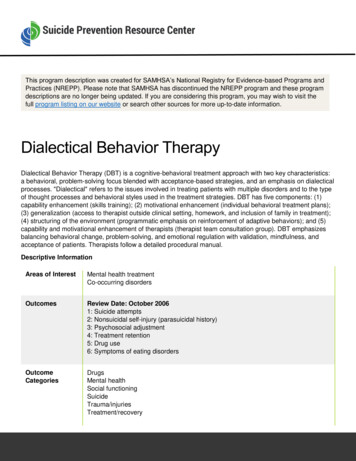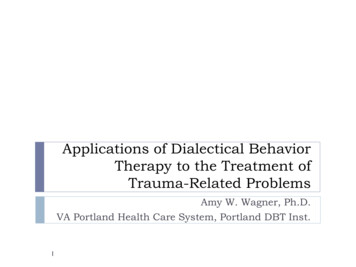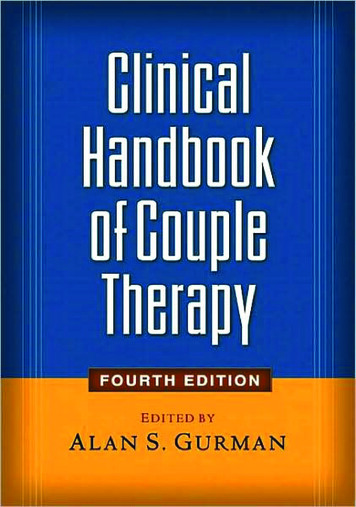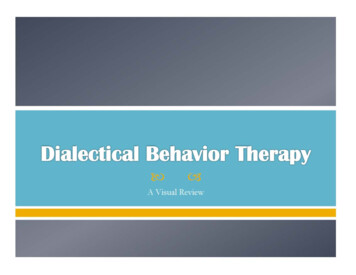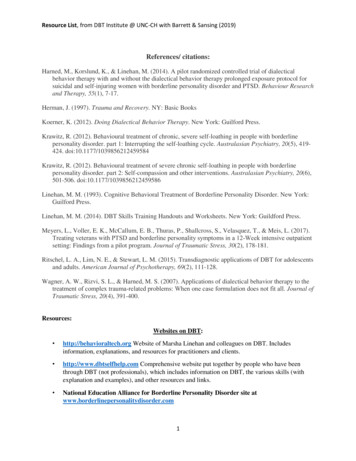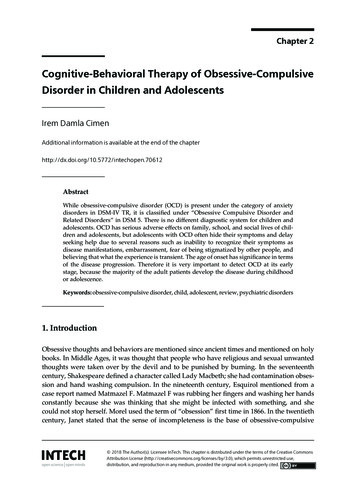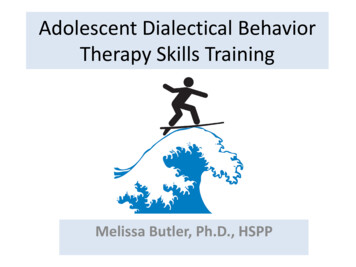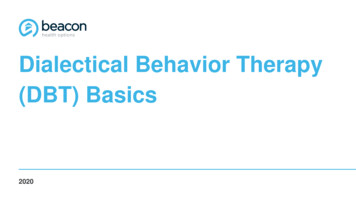
Transcription
DialecticalBehavioralTherapy in a NutshellJames A. Jenkins, MDMedical Director, 3 East Cambridge ResidenceSpring 2018
LearningObjectives1. Be familiar with the efficacy of DBT to treatBPD and some of its comorbities2. Understand what the term ”dialectical” meansand how it influences the theory andassumptions that underscore a DBT treatment3. Recognize the core dialectical dilemmas faced bythose with BPD and their family members4. Understand what the term “behavioral” meansand how this links to therapeutic interventionsand treatment team recommendations
The Birth ofDBT:BalancingAcceptanceand Change Developed in the late 1980s at University of Washington byMarsha Linehan PhD who was studying self-destructive andchronically suicidal individuals Started with Cognitive Behavioral Therapy, but noticed thatpatients were not improving and sometimes got much worse Marsha incorporated acceptance strategies from Zen Buddhismto balance out the change focus of CBT She also developed skills modules and assertiveness training tohelp patients become more effective in accomplishing theirgoals Published her treatment in 1993 and it was quicklydisseminated, adapted, and implemented in a variety ofenvironments
MarshaLinehan, in herown words .“DBT is a comprehensive cognitive-behavioral treatmentfor complex, difficult-to-treat mental disorders it’soverriding characteristic is an emphasis on ‘dialectics’that is, the reconciliation of opposites in a continualprocess of synthesis. The most fundamental dialectic isthe necessity of accepting patients just as they are withina context of trying to teach them to change Thisemphasis on acceptance as the balance to change flowsdirectly from the integration of a perspective drawnfrom Eastern (Zen) practice with Western psychologicalpractice the continuing effort in DBT is to ‘reframe’suicidal and other dysfunctional behaviors as part of thepatient’s learned problem solving repertoire ”Marsha Linehan. Cognitive-Behavioral Treatment of Borderline Personality Disorder.New York: Guilford Press. 1993. pp 19-21
Moresimply DBT emphasizes balancingbehavioral change, problemsolving, and emotionalregulation with validation,mindfulness, and acceptance.
Stages of TreatmentThe Path outof HellSkills to Learn1. Commit to building a lifeworth living and setting goals2. Reduce life threateningbehaviors and gainbehavioral control3. Reduce desperation andhopelessness and begin tofully experience emotions4. Tackle problems of dailyliving and achieve ordinaryhappiness and unhappiness5. Develop capacity for joy andfreedom. Find a sense ofpurpose and move towardscompleteness vs. emptiness1. Core MindfulnessSkills2. Distress ToleranceSkills3. Emotion RegulationSkills4. InterpersonalEffectiveness Skills
What is theefficacy ofDBT to treatBPD? First RCT was performed in 1991 8 published peer-reviewed articles from 1993-200 41 publications per year from 2001 to 2010 78 publications per year since 2011 Estimated effect size of DBT for BPD is between 0.5and 0.6 (about the same as blood pressure medicine) In comparison, antidepressants have an effect sizeof 0.38 Been adapted to treat: Adolescents, substance abuse,bulimia, post-traumatic stress disorder, bipolardisorder, anger management, and perpetrators ofviolence (forensic setting)
What do wemean whenwe refer todialectics?Two seemingly opposing truths can both be truesimultaneously:- Reality is Whole and interrelated: the parts make upthe whole, the whole is made up of parts- Reality is complex and in polarity- Everything and every person is connected in someway- Change is continual and transactionalResists oversimplification, promotes freedom,flexibility, and balance.
UnrelentingCrisisEmotionalVulnerabilityActive g
hologic BehaviorsPathologizingNormal BehaviorsForcingAutonomyAuthoritarianControl
Regarding Patients Clients are doing the best theycan Clients want to improveWhat is thetherapist’sstance inDBT? Clients cannot fail in DBTRegarding Therapy The most caring thing therapistscan do is to help clients change Clarity, precision, and compassionare of the utmost importance in theconduct of DBT The lives of suicidal individuals The relationship between therapistsand clients is a real relationshipare unbearable as they arebetween equalscurrently being lived Therapists can fail to apply the Clients must learn newbehaviors in all relevant contexts treatment effectively. Even whenapplied effectively, DBT can fail to Clients may not have caused all achieve the desired outcomeof their own problems, but they Therapists who treat individualhave to resolve them anywaywith pervasive emotion Clients need to do better, trydysregulation and Stage 1 behaviorsharder, and/or be moreneed supportmotivated to change
“By nature, behavioral therapies are empirical“Behavior isdetermined by its (data-driven), contextual (focused on theconsequences.” environment and context), functional (interestedin the effect or consequence a behaviorultimately has), probabilistic (viewing behavior asstatistically predictable), monistic (rejectingmind-body dualism and treating the person as aunit), and relational (analyzing bidirectionalinteractions).”Sundberg, Norman (2001). Clinical Psychology: Evolving Theory,Practice, and Research. Englewood Cliffs: Prentice Hall.
How canDBT helpfamilies,couples, andindividualswithoutBPD? Understand the (seemingly) unexplainable Learn to take a dialectical position, or at leastnotice dialectical failures Increase awareness of transactional elements ofbehaviors Give a common language to describe skillful vsineffective approaches and a commonunderstanding for how to change course
The High Conflict Couple by Alan Fruzzetti, 2006 The Family Guide to Borderline PersonalityDisorder by Alan Fruzzetti, 2017Resourcesfor furtherreading: Parenting a Child Who has Intense Emotions byPat Harvey and Jeanine Penzo, 2009 The Dialectical Behavior Therapy Skills Workbookby Matthew McKay et al. Borderlinepersonalitydisorder.com Family Connections Program
Dialectical Behavioral Therapy in a Nutshell James A. Jenkins, MD Medical Director, 3 East Cambridge Residence Spring 2018. Learning . behavioral change, problem-solving, and emotional regulation with validation, mindfulness, and acceptance. The Path out
